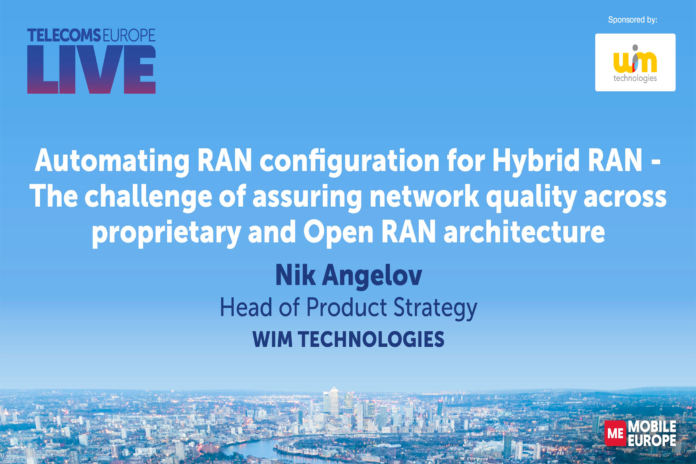At Telecom Europe LIVE, WIM warns that operators can’t remain reactive on Open RAN service assurance
Despite Open RAN hype in many quarters, WIM Technologies head of product strategy Nik Angelov pointed out that even by 2030 only around 30% of RANs will be open architecture, which means most operators will still be running proprietary RAN, leading to hybrid RAN models dominating for the foreseeable future. This inevitably means an increased architectural complexity and an increased operational cost of managing that complexity.
Angelov warned that operators are too focused on the burning open architecture questions of which software, cloud and hardware vendors they should choose for Open RAN and are overlooking to big service assurance challenges they will have to overcome.
He said operators still have completely different structures for the teams responsible for systems architecture, hardware architecture and those that are responsible for operating the radio network.
This will make operators terminally reactive. Users will complain and services will need to be reconfigured, but the engineers may not be able to assure them in a hybrid environment. They’ll complain they don’t have the systems to deliver that, or the people.
Watch the video of his session.
RAN so far away
Operators using more than one proprietary RAN are already typically deploying these by segregating them geographically to minimise the challenge of assuring interoperability and optimisation that goes across those two boundaries.
So, while operators have mostly been able to assure consistent user experiences across proprietary RANs, even when it is the same technology like 2G, the configuration of those parameters to deliver similar features requires different instruction sets – and there can be many thousands of parameters to manage.
But early indications show operators are deploying Open RAN alongside proprietary RAN architecture to support things like small cells of 5G capacity increases. As a result, the interactions between these two networks are much closer than before and this challenges network quality.
Single vendor operators will need to handle two types of architectures if they adopt Open RAN. Operators with two or more vendors will get another set of radio configurations, requiring more knowledge and then process changes for how configurations are managed.
“We see a huge difference between options and parameters on different vendors and we do expect that to be also [the case] on Open RAN software,” said Angelov. “So that means that a lot of consideration needs to be taken in terms of how actually things need to be configured in order for the end user experience to be similar or same.”
He highlighted how engineers will need to focus on transmission power control, modulation encoding, handover and mobility parameters, load balancing and cell reselection as areas that engineers will need to assure, particularly how they interplay with signal strength, data speeds and quality, dropped calls and capacity management.
Another RAN brick in the wall
Angelov warned that proprietary RANs typically don’t have truly open interfaces meaning any third-party interfaces are very specific for each RAN vendor. Intelligent optimisation is carried out by a SON module or service module orchestration, also covering configuration management.
“However, Open RAN introduces new open interfaces like near real time RIC, non-real time RIC responsible for intelligent optimisation, service management and orchestration framework responsible for aspects related to baseline policy management and overall radio design,” he said.
As a result, operators are creating a wall instead of addressing how this can be managed effectively to create a seamless hybrid network. Instead, he says, operators are throwing more engineers at this to solve the interfaces manually.
“If an operator already has more than one proprietary vendor, they might have bought a third-party solution for centralised SON to do intelligent optimisation,” he said. “When they bring Open RAN that the centralised SON needs may not actually work on the RAN because on the RAN, now the SON function is taken by a RIC…Big operators can no longer say ‘My SON solution will cover Open RAN’. It won’t.”
“The answer is really going into automation; going into solutions that can actually carry [out] optimisation, carry out configuration and run quality assurance across the different types of architectures,” he said. “With an open architecture we have a lot of possibilities for minimising the need for human interaction or manual labor related to implementation of the radio configuration, the implementation of the parameter settings.”



